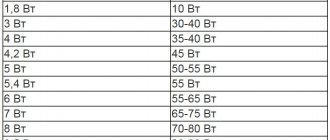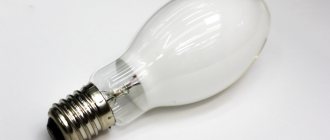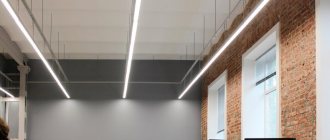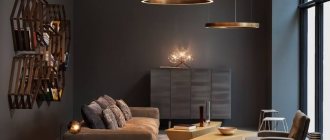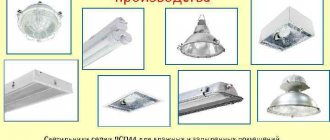When placing lighting fixtures in rooms, you need to remember such a concept as calculation of illumination. Uniform illumination of the entire room, most favorably perceived by the eye, depends on this. Chaotic and ill-conceived installation of lighting devices will lead to the appearance of too bright or dark areas that negatively affect vision. It is difficult to make accurate calculations on your own, since many factors must be taken into account, from the characteristics of the lamps to the reflected surfaces of various objects in the room. Let's learn how to make a simple calculation of LED lighting for your home.
Why is the calculation needed?
First of all, calculations are needed for optimal lighting of the entire area of the room in order to create comfortable living conditions. Too much or too little light increases eye strain. Such discomfort even affects a person’s mental state, making him irritable.
The standard of illumination for the human eye is natural daylight in sunny weather. Correct calculation should bring the artificial light emitted by lamps closer to natural light. SNiP documentation reflects lighting standards for a specific room. It's time to get acquainted with them and try to independently calculate the number of LED lighting devices.
How to determine how many lamps are needed for a specific room
Even using the basic information outlined above, you can calculate how many spotlights will be needed in the room. There are simple tips for this:
- Determine the area of the room by measuring the length and width.
- Using the table, determine the norm of illumination per square meter. Multiply by area to get an approximate result.
- Select the lamps, then divide the final number from the point above by the power of one element. If the value is fractional, it is better to round up.
- If there are several options with different powers, it is worth using less powerful lamps and installing more of them. Then the light will be more uniform and more comfortable for the eyes.
Isolating a work area using spotlights.
Division of LED lighting into types
Before moving on to familiarizing yourself with the standards and performing calculations, you need to understand the types of lighting. The requirements will depend on this.
Lighting is divided into 3 types:
- Accent lighting is used by designers to decorate the interior of a room. With the help of different light shades and visual effects, you can create the desired atmosphere in the room. For such lighting, economical light sources are most often used, for example, LED strips and small lamps. There are no special requirements for accent lighting.
- Local lighting is aimed at supplying a certain amount of light to the work area. This could be a table, a place in the kitchen, a machine at an enterprise, etc. Using local lighting, designers divide a large room into zones.
- General lighting is designed to supply a certain amount of light indoors.
Having understood the types of lighting, it’s time to familiarize yourself with the standards themselves.
Proper lighting of the production area
By type, industrial lighting of a room (like any other) is divided into natural and artificial.
Natural light is the most valuable: the human eye is most adapted to it. It enters the building through windows and other transparent building structures (for example, aeration skylights).
Daylight
Types of artificial lighting:
- general;
- local;
- combined.
Local lighting is not used by itself; it is used only in combination with general lighting. A suitable lighting device can be portable or stationary. The light spot from it does not even illuminate the areas adjacent to it.
Combined building illumination method
Combined - required when workers perform high-precision operations that do not allow the appearance of sharp shadows from any objects.
Only combined lighting can ensure compliance with safety standards at the enterprise
General - organized in workshops with the same type of work (for example, in foundries). There are cases when combined lighting is simply not possible to organize.
For maximum efficiency, you can illuminate technical or street areas with devices with motion sensors to turn on the lights.
Lighting standards for certain rooms
Having come close to the concept of room illumination, it is time to forget about watts and volts and stop at lux (Lx). It is in these values that these measurements occur. If the light throughout the apartment is the same, for example, diffused or bright, this will cause discomfort and visual fatigue.
Existing SNiP rules have illumination standards, measured in the same lux, for each room. For convenience, these data are shown in the table.
Each value corresponds to the amount of luminous flux directed at 1 m2 of room area. However, we must also take into account the height of the ceilings. These tables reflect the values for rooms with a ceiling height of 2.5 to 3 m. The fact is that the closer the location of the LED lamps to the illuminated surface, the more effective the useful flow of light. So, with the ceiling raised above normal, the lux values in the table must be increased by 1.5–1.7 times.
How to calculate lighting using the formula
Like any problem, ours has several solutions.
A simple formula for calculating the area of a room
X=A*B*C, where:
X – luminous flux level (lm).
A is the established norm for the premises in question.
B – area (m2).
C – ceiling height coefficient. (for standard ceilings up to 2.7 m C=1; for high ceilings up to 3.5 m C=1.5; for very high ceilings up to 4 m C=2).
Let's say we need to choose lamps for an office with an area of 16 sq.m. in a new building with 3 meter ceilings.
X=200*16*1.5=4800 (lm).
But how many lamps do we need? To do this, refer to the table below.
If your choice fell on office lamps Ziverd BURO S opal with a power of 18 W. 4800/1800 = 2.67. That is, three products will be enough for the office in question.
Please note that the luminous flux of modern LED lamps may differ from standard values. In the manufacturer's catalog, this indicator is also indicated among the characteristics of the product.
Don't forget to take it into account. So, for the BURO S opal model it is 2100.
Example of a simple calculation
So, having understood the concepts a little and having a table at hand, let’s try to independently make a simple calculation of the illumination of an apartment with LED lamps. Each LED light source on the packaging or in the passport contains an indicator of the magnitude of the luminous flux. To calculate the illumination indicator of a certain room, you need to multiply the square footage of the room by the value from the table and divide all this by the luminous flux of the LED light source, measured in lumens.
Let's make a calculation, for example, for a children's room. According to the table, the indicator for such a room is 200 Lux/1 m2. Let the total area of the nursery be 12 m2, and LED lamps with a value of 400 lumens are used as light sources. We perform a simple mathematical operation: (12x200)/400 = 6. The result means that for this children's room you need 6 LED light bulbs with a luminous flux of 400 lumens.
Typically, 11 W LED bulbs have a luminous flux of 800 lumens. You can find out the number of such light sources using the same mathematical operations: (12x200)/800 = 3 light bulbs.
Often, when calculating the required number of lamps, the result is fractional. This value must be rounded, and in which direction - more or less, let the owner of the house decide. It all depends on the preference for light brightness.
How to choose the right lamps
Lamps should not be selected based on only one indicator, even if it is very important.
In addition to lumens, other criteria must be taken into account:
- color temperature;
- efficiency of light sources (power);
- type of power source (220 V, 12 V);
- possibility of dimming;
- correspondence of bases to lamp sockets, sizes of light bulbs to shades;
- lamp service life.
The most economical light sources are selected first, rational lamps are selected for them, and only then is it determined how much light is required by area. It is advisable to take into account the reflectivity of walls and interior items and the margin that may be required when individual lamps fail. Upon completion of the calculations, a sketch of the system is created.
Particular attention must be paid to calculations when planning LED lighting. These light bulbs are currently the most economical
For example, a 14W LED bulb produces the same lumen output as a 100W incandescent bulb.
Colorful temperature
This indicator refers to those that directly affect the psychological state of people. 2500-300 K light bulbs are suitable for bedrooms, installation together with a chandelier in floor lamps and sconces in living rooms. Sources at 3000-4000 K are the best option for residential premises. 4000-5000 K lamps should be purchased for the kitchen workplace and reading corners in living rooms.
Light flow
When falling on a body, the light flux is divided into 3 parts: absorbed, reflected and transmitted. In order for the calculations to be as accurate as possible, appropriate coefficients are used, which complicates the calculation process. To determine the useful performance of the luminous flux, it is better to use lux, which allows you to determine what part of the light emitted by the light bulb reaches each square meter of a specific area.
To determine how many bulbs are needed to achieve the desired light level, the light flux is first calculated. It is necessary to multiply the norm taken from the table. By the area of the room, then by a coefficient depending on the height of the ceilings (for 2-7-3 m it is 1.2, for 3-3.5 m it is 1.5).
To determine their number, it is enough to divide the result obtained in the calculations by the number of lumens indicated on the factory packaging of the light bulbs.
If the final result is not an integer, it is rounded up.
However, with this method of calculation, it is necessary to take into account that the light in the room will be smoother the more light sources there are. Therefore, if you plan to make designer lighting with several lamps built into the ceiling, then we would recommend using 8 LED bulbs of 5 Watt each and distributing them along the ceiling at an equal distance from each other, or concentrating them in the most needed area of the room
Diffuser type
The main purpose of the diffuser (in everyday life it is a lampshade) is to evenly distribute the flow of light coming from the light bulb. The choice depends on which chandeliers members of a particular family prefer. The light bulbs in them can “look” both down and up. In the first option, the light flux is directed to the floor; the lampshade does not allow it to illuminate the corners, which requires the installation of additional local lamps.
In the second option, the luminous flux is first directed to the ceiling, only then is it evenly dispersed over the area. This means that chandeliers with bulbs that “look” upward are more comfortable for people.
It is also important to choose the right lampshade material. They are made from glass, plastics, metals and even paper
When choosing, you should not focus on decorative qualities; safety is more important.
For example, if you use incandescent light bulbs in a chandelier with plastic lampshades, it will not last long. No tags for this post.
How to find out the light level?
It's time to get acquainted with another concept, the level of illumination. To determine the intensity of light sources intended for different rooms, there is a formula:
Ф = E*S*Кз
In this case, E is the illumination value for 1 m2 of room, taken from the table. S is the total area of the room.
As for Kz, this is a safety factor. This value depends on the amount of light reflected by different surfaces of the room and the mounting height of the light sources. To accurately determine the level, professionals use special tables that display the degree of light reflection from each object in the room. However, such calculations are complex, and for an ordinary person you just need to know that Kz for a residential premises is equal to 1.1. Naturally, this is a safety factor for rooms with LED light sources. For clarity, the room illumination level can be determined from the table.
Which lamps to choose for lighting
The critical parameters on which the quality of lighting depends are:
- color temperature;
- diffuser type;
- light flow.
Colorful temperature
Traditionally, color temperature can be divided into three main ranges:
- warm white light – 2500-3000 K;
- white – 3000-4200 K;
- cool white – 4500 K and above.
The higher the color temperature, the brighter the lamps shine, while it is not recommended to use too cold shades in the bedroom and rest rooms, and warm shades in reading areas.
Diffuser type
LED lamps use frosted or transparent lenses. In the first case, the light is distributed as evenly as possible, but losses can reach 20-30%. Recommendations for use are simple: if it is necessary to illuminate rooms with a large area, you need to use transparent diffusers; for table or wall lamps - matte ones.
Light flow
When choosing an LED lamp, pay attention to its rated luminous flux. Its value depends on a number of factors and the country of origin. On average, for diode products with a power of 4.8 W, the following dependence is observed:
- lamps from China – 240 lm;
- Taiwan - 380-420 lm;
- Europe – 500 lm and above.
Do not forget that the wattage of a lamp with warmer light should be 20-25% higher than that of sources with cool white light.
The overall illumination of the room, of course, depends on the number of LED lamps, but these are not all the parameters that need to be taken into account when choosing. Be sure to focus on the color temperature, luminous flux and power of the product. To create a uniform glow using LEDs, it is important to perform the most accurate calculations so that it does not turn out that one room is lit too brightly, while another is sorely lacking in light.
Simple calculation of spotlights
Since all our calculations are based on simple technology, we will determine the number of spotlights using the lazy method. Of course, it will not give perfectly accurate results, but for your own apartment it will help you easily calculate the optimal number of light sources.
So, to calculate the number of LED lamps, we need to return to the lighting level of 1 m2 of the room. If we take classic incandescent lamps, then according to the generally accepted standard, 20 W of the power of this light source is required per 1 m2 of room. Now we return to mathematics again. Let's say there is a room with an area of 12 m2. This number must be multiplied by 20 W. The result obtained suggests that the room requires a classic lamp power of 240 W.
Now all that remains is to find out from the passport the equivalent of a spotlight to a traditional lamp and select such a number of them that the total power is equal to the equivalent of 240 W.
Why LEDs
But in fact, how are LEDs superior to the usual incandescent lamps, halogens and energy-saving lamps, and in what ways are they inferior to them?
Advantages
- The first and main advantage of LEDs is their low power consumption per unit of luminosity. In order not to be unfounded, we give specific values for popular types of lamps:
| Image | Description and luminosity per watt of power consumption |
| Incandescent lamp: a vacuum bulb with a tungsten filament heated to a white glow. Delivers 8-10 lumens per watt. |
| Halogen lamp: the bulb is filled with bromine or iodine vapor. Halogens prevent evaporated tungsten atoms from settling on the bulb and thereby help raise the temperature of the filament, while simultaneously increasing the life of the lamp. Light output reaches 12-15 lumens per watt. |
| A compact fluorescent (also energy-saving) light bulb is a classic fluorescent lamp with a compact driver built into the base. Light output reaches 50-70 lm/W. |
| LED lamp - LEDs combined in one housing, soldered on a rigid substrate, and a driver (power converter). The luminous efficiency of modern LED lamps exceeds 100-120 lm/W. |
Note: the luminosity of individual LEDs of the latest generations comes close to 200 lumens per watt. The performance of household and industrial lamps is inferior to these values due to losses on the power converter.
- The heating of an LED lamp is noticeably lower than that of a compact fluorescent or halogen lamp, not to mention the good old Ilyich light bulb. It is logical: the higher the efficiency, the less energy is released in the form of heat. Hence the possibility of installing lamps in conditions of limited ventilation and inside structures that do not tolerate heat well (stretch and plastic suspended ceilings, plasterboard niches, etc.);
LED mortise lamp for suspended or suspended ceiling
- Due to their large area, powerful lamps and LED strips create fewer shadows. This is important when working with small details, when typing text, and when working as a makeup artist and hairdresser;
Shadows? No, we haven't heard
- The service life of lamps and fixtures is estimated at 30-50 thousand hours. Incandescent lamps last about 1000 hours, halogen lamps - 3-5 thousand, fluorescent lamps - 10-12.
The dark side of LED
No, no, we do not mean discussing the structure of the LED crystal substrate. Alas, LED lighting has a couple of... let's say tactfully - features compared to alternatives.
- Price: on average it is still higher than other types of lamps. Although the gap is rapidly closing: the author no more than a week ago purchased a batch of LED lamps with a luminosity of 800 lumens for 68 rubles. For comparison, more or less high-quality halogens cost 50-60 rubles.
- Color rendering: the color rendering index (CRI) of the best LED lamps reaches 85-90%. For halogen lamps it is close to 100%, for most incandescent lamps it is above 90%.
Appearance of an object at the same color temperature and different lighting color rendering indices
Help: how natural the colors look depends on the color rendering. The color rendering index of lighting is important in design work, as well as for notorious hairdressers and makeup artists. Makeup done in low CRI lighting may look unnatural in daylight.
- Operating voltage range: for the latest generations of lamps it is much less than for incandescent and halogen lamps. The reason is the decline in market prices mentioned above.
It entails simplification of the driver circuitry. If in the first generations of lamps it was a full-fledged switching power converter with a stable output voltage - regardless of what is happening at the input, then in the newest filament lamps (on LED filaments) the role of the driver is played by... a diode bridge - the simplest AC converter to constant.
Preparation of an inexpensive filament light bulb: the role of the driver is performed by a simple current rectifier
The video attached to the article will help you learn more about them.
Simple energy efficiency calculation
This calculation does not affect the illumination of the room in any way and is carried out only for economic reasons. In other words, the owner calculates the energy savings of his home after replacing incandescent lamps with LED light sources.
To perform an energy efficiency calculation, let's take a standard apartment that previously had 20 75 W incandescent lamps. Let’s say they shine for 3 hours a day. In 1 month this figure will increase to 90 hours. Now let’s calculate how much electricity these 20 light bulbs consume per month: 75x90x20 = 135 kW. By multiplying this result by the electricity tariff, you can easily find out the amount of expenses per month.
A similar calculation is made for LED lamps. We take the same number of LED lamps, only in equivalent to traditional ones their power is 10 W. We perform a mathematical calculation: 10x90x20 = 18 kW. By multiplying the result by the electricity tariff, the result is immediately visible.
However, we must take into account that the cost of an LED lamp is much higher than a regular one. But if you calculate the difference in payment for electricity and the cost of purchasing lamps, it turns out that 2 LED lamps will pay for themselves every month. The apartment uses 20 light sources, which means they will pay for themselves in 10 months, and then there are only savings.
That's basically all the simple calculations you might need at home. If more complex and precise expenses are required, it is better to turn to specialists.
Requirements and wishes for lighting arrangement
Before you begin planning and calculating the lighting system of a room, it is necessary to formulate what basic criteria it must meet.
The main ones are:
- Comfortable illumination, that is, light enough for reading, communication, homework, but does not hurt the eyes. This indicator is different for everyone, as it depends on the state of vision, habits and preferences.
- Convenient placement of lamps that should provide light to the entire area of the room, but the level of illumination may differ in different parts of the room.
- Cost-effectiveness, namely, the amount of the monthly payment for electricity, the cost of the light bulbs themselves (for one and for the entire number), the service life of the light bulbs (how often they will have to be purchased).
If you take into account all these requirements, then the optimal solution will be the choice of LED lamps. In terms of light level, they are equal to incandescent lamps, but they consume significantly less electricity and last for several years. Compared to energy-saving fluorescent lamps, LED analogs are more compact in shape and have a pleasant glow. Now it is necessary to calculate the illumination of the room with LED lamps in order to calculate how many and what power of lamps is needed for sufficient lighting.
Features of suspended ceiling lighting
Calculation of the number of lamps in a suspended ceiling must be carried out taking into account some of the features of this material. This is due to the fact that the characteristics of the canvas differ from traditional options. It is worth considering the following:
- Glossy surfaces reflect light much better than any other ceiling covering. This applies to both light and dark options. Lamps on such bases provide excellent quality of light, especially if positioned correctly.
- The canvas does not tolerate overheating well, so it is better not to use incandescent lamps and halogen options. The minimum distance from the suspended ceiling to the ceiling when using such options should be 20 cm, which is not very good, since a lot of space is lost.
- Installation is also different, since the bases for spotlights are attached before the ceiling is laid. You need to make a clear diagram in advance and determine the location in order to connect the wires and secure platforms of the appropriate size.
Amendments to calculations
The same applies to the height of the ceilings - if they are higher than three meters, increase the calculated parameter by one and a half times. Otherwise, the lighting intensity in the residential area will be insufficient - the luminous flux simply will not reach the work surfaces, being wasted. It is also necessary to take into account that, due to their design features, LED lamps have a narrower scattering angle than conventional ones - about 130-150˚. Therefore, to distribute light evenly, it is advisable to place lamps around the entire perimeter of the room, or simply use several lamps at once, installed at different levels: walls, ceiling, floor. Well, a purely aesthetic recommendation - for residential premises it is better to choose LED models - lamps that shine in the “warm” yellow spectrum, and for work areas where increased illumination is needed - in the “cold” white-blue spectrum. The first one is subjectively perceived as soft, the second one seems more intense and bright.
Task No. 2 - calculating the number of lamps
Inverse problem. As I said above, there may be another task: you have decided on LED lamps, they suit you in terms of price, you know their characteristics, and you need to calculate the number of such lamps to provide the required illumination in the room, then use the formula:
Only now, instead of the number of lamps, we need to substitute the luminous flux of one lamp.
For example, you have cheap 3 W LED lamps in your store with a luminous flux of 215 lm (a lamp with such parameters actually exists) and you decide to purchase them.
We use the above formula, all parameters remain the same: I think that in this case we can round down, that is, take 12 lamps to arrange the lamps in three rows of four.
Meaning of light
Light has always been of great importance for people, since it is the visual analyzer that provides us with almost 90% of the information about the world around us. And in the conditions of computerization of society, not every person is able to maintain visual acuity at the proper level.
At the same time, you can significantly deteriorate your vision even without working at a computer for 8 hours a day. It is enough to make poor lighting in your home and you will be provided with a set of problems in just a couple of years. Just the right lighting, which is created in the house by various types of lighting fixtures, will allow you to increase your productivity, normalize the microclimate in the family and take a more effective break from work.
Directional light
Since we spend most of our time at home (of course, after work), we need to approach the lighting of the apartment as responsibly and thoughtfully as possible. After all, this is where no one can put you in to make your life better and more comfortable. Light in the house can be supplied as follows:
- directed. This lighting is created by ceiling chandeliers and wall sconces with floor lamps;
- scattered. Such light is possible from hidden backlights, which have recently become very popular. They look especially beautiful on plasterboard and suspended ceiling structures. Unlike directional lighting, diffuse lighting alone cannot independently provide the required level of light in the room. Therefore, it often acts as additional lighting.
Diffuse lighting
It is also worth noting that a room in the house such as the kitchen requires additional lighting in certain areas. It is with the kitchen that many people have problems in terms of creating proper lighting. This is due to the fact that the kitchen is often small in size and is always filled with all kinds of kitchen utensils, devices and cabinets. As a result, there are many dark and poorly lit areas. To help solve this problem:
- spotlights installed above the work area (countertop, sink, stove);
- LED cabinet lighting.
But in any case, before installing certain lighting fixtures, you need to find out what degree of illumination you need. For these purposes, you should seek help from SNiP.
Types of lighting
Modern technologies make it possible to install not only central lighting in rooms, but also additional lighting. This approach allows you to control the luminous flux by setting the required lighting power. The following types of lighting are distinguished:
- directional - main sources - chandeliers, floor lamps, lamps;
- diffused – additional light sources mounted on ceilings and walls.
The combination of these two types of lighting in rooms allows you to create ideal indoor conditions for work and relaxation.
Impact of the wrong light
Light is a necessary condition for a comfortable human life. Sanitary doctors have calculated standards and criteria for residential premises that have a beneficial effect on human health and mental state.
In apartments, windows are provided for natural light, but at night it is necessary to turn on artificial lighting. Lack of light in living rooms can lead to the following deviations:
- irritability and fear;
- headache;
- decreased performance;
- fatigue;
- insomnia;
- fatigue and redness of the eyes;
- exacerbation of chronic diseases.
Children suffer the most from lack of lighting in living rooms. If they have to do homework, read or play, or use gadgets in poor lighting, they may develop visual impairment.
This problem will only get worse over the years.
Therefore, in a child’s room it is important to consider multi-level lighting of the room in order to illuminate the room, work and play area
Calculation of room illumination with LED lamps
Calculation of LED lighting in an apartment
Calculation of LED lighting allows you to organize an effective lighting system. One of the main features of such lamps is the high brightness of the light, and, in addition, they are characterized by directional radiation, which is a plus under certain conditions, but a disadvantage in others. To ensure that the room is illuminated with LED lamps as evenly as possible, you should use some tricks.
Room lighting standards
The efficiency of light radiation in an apartment should be different. If in any of the rooms the glow is equally bright, directed or, conversely, diffused, then the level of comfort will noticeably decrease.
Indoor lighting standards
Therefore, in rooms for different purposes, SNiP provides for several levels of illumination:
- apartment hallway – 100-200 lux;
- home office – 300 lux;
- living room – 150 lux;
- bedroom – 200 lux;
- kitchen – 150-300 lux;
- children's room - 200 lux;
- bathroom – 50-200 lux.
The area of the room and its height are key factors in determining whether the light is bright enough. Much depends on the type of lighting: main light; local; functional; decorative lighting. The standards indicate different light levels for some rooms.
When creating a functional lighting system, the lamp must emit brighter light. Decorative lighting requires the installation of low-efficiency lamps. The above illumination indicators are suitable for residential premises with a height of 2.5-3 m.
How to achieve uniform lighting?
If LED emitters are used, you should consider their location, taking into account the main parameter - luminous flux. The brighter the radiation of the lamps, the further they are installed from each other.
To cover the entire area of the room or a separate area, it is recommended to pre-calculate a sufficient number of lamps.
Uniform ceiling light is organized by installing different types of lighting elements. You can choose different combinations: a central lamp (chandelier) and point emitters installed according to different patterns; several ceiling fixtures of the main light and decorative light; point emitters in the required quantity and with suitable characteristics, used to organize the main light without the use of a chandelier.
Light level detection
The overall glow intensity of lamps for rooms with different purposes is determined as follows:
- Ф = E*S*kз,
- where E is the illumination of 1 square. m;
- S – area;
- Kz – safety factor.
The last of these parameters directly depends on the installation height of the lamps and the reflectivity of different surfaces (walls, ceilings, floors). For housing, but only if diode-based lamps are installed, this figure is 1.1.
As an example, consider the calculation of LED lighting for a nursery:
Accordingly, in such conditions it is necessary to use emitters that are characterized by a luminous flux of the required value, so that in total a value of 1,320 lm can be obtained.
How many lamps do you need?
There are different formulas for calculating the number of lamps and devices. Much depends on their type. For example, in point models there is usually only one light source installed; therefore, in order to calculate the number of such devices, you need to divide the total illumination (F) by the luminous flux of one emitter.
If there is another task: to determine how many lamps with several bulbs are needed, then it is recommended to apply the following formula:
- N = (E*S*kз*z*100)/(n*Ф*ɳ),
- where E – standardized illumination, lux (tabular value);
- S – room area, sq. m;
- kз – safety factor (1.1);
- z – value of illumination unevenness (for diode lamps equals 1);
- Ф – luminous flux of the emitter, lm;
- ɳ is the coefficient of the lighting element (equal to 1);
- n is the number of lighting elements in one device.
As a result, you can calculate the required level of illumination as accurately as possible and find out how many lighting fixtures need to be installed. In any case, it is always better to be guided by approximate data than to organize lighting “by eye”.
You should also consider the type of light bulbs used. They may differ in base (threaded, pin), color temperature (from warm to cold shades), power.
In particular, diode emitters for home are characterized by a low load on the network: from 3 to 15 W. This is enough to provide bright light for living spaces.
Thus, the overall illumination of the room will depend on the number of devices. But, in addition, lamp parameters must be taken into account: color temperature, luminous flux, power. To obtain a uniform glow using LED devices, you need to be guided by calculations, otherwise some areas of the room may not be well lit enough, while others, on the contrary, may be too brightly lit.
You can choose any of the existing lighting schemes. The most commonly used options: with a chandelier and spot lighting; Without a main lighting fixture, functional light is provided by spotlights.
Calculation of room illumination with LED lamps
Reducing prices for LED lamps and rising electricity tariffs makes installing them in an apartment more attractive every day. In addition to significant savings in energy costs, they allow you to create lighting that is closest in spectrum to daylight.
The most pressing question when replacing ordinary incandescent light bulbs with LED ones is how to calculate the required number of LED lamps. It’s common for us to have a 60-watt light bulb in the toilet, and three or four 100-watt bulbs in the living room. But for LEDs such parameters are not applicable. During installation, it is necessary to determine the total luminous flux.
Calculation of illumination of premises for various purposes
For each room, the level of illumination is selected individually and depends on what work will be carried out in the room. In those rooms where you will read or write, the brightness should be maximum, but for the corridor the illumination level is almost an order of magnitude lower.
The easiest way to select a replacement for filaments is based on the table of their luminous fluxes.
Incandescent lamp luminous flux
Let's take as an example a living room with an area of 20 square meters, in which there are four ordinary incandescent lamps of 100 W each. The total luminous flux of such a chandelier will be 1200*4=4800 lumens . We divide the luminous flux by the area of the room: 4800/20 = 220 lumens/sq.m (lux) .
Calculation of lighting with LED lamps, online calculator
Very simple formulas are used here:
We calculate the number of LED lamps by area based on the size of the room and the required level of lighting.
Luminous flux of one lamp = illumination level * room area / number of lamps
Calculation of LED lighting per square meter:
Illumination level = number of lamps * lamp luminous flux / lighting area
How many LED lamps are needed per square meter depends on the type of installation of the lamps. If LEDs are installed in a regular chandelier, their luminous flux is selected based on the required level of light intensity. When installing spotlights around the perimeter, we divide the required level by the luminous flux of the lamps that we plan to install.
We should not forget that the effective angle of light of LEDs is about 120 degrees, so the number of lamps per square meter should be such that the light is uniform, without differences. This is achieved by increasing the number of light sources with a proportional decrease in the power of each source.
It should be noted that the light bulbs located in the ceiling are 20-30 cm higher than in the chandelier, so the light intensity should be 15-20% higher.
To determine the number of light sources, you can use a calculator for calculating room illumination with LED lamps:
Which lamps to choose for lighting
When choosing LED light bulbs, you should pay attention to the most critical parameters that are important for the quality of lighting.
- Colorful temperature;
- Diffuser type;
- Light flow.
LED color temperature traditionally has three categories
- WW - warm white (color temperature 2500-3000 K);
- W - white (color temperature 3000-4200 K);
- CW - cool white (color temperature above 4500 K).
Visually, higher color temperatures produce brighter light. So, at the same power, the visual brightness of CW is a quarter higher than WW.
The diffuser can be matte or transparent. A matte diffuser provides a more uniform distribution of light flux, but intensity losses in it can reach 25-30%. To illuminate a relatively large area of the room, it is more rational to use lamps with a transparent diffuser, but in a table lamp the matte type of diffuser is definitely better.
When choosing a light bulb, be sure to pay attention to its rated luminous flux. It depends on the type and quality of LED matrices.
The required power of an LED lamp depends on the parameters discussed above. When using warm light, the rated power should be 25-30% higher than cold light lamps.
Inaccuracies and errors when calculating LED lighting
Often, ordinary light bulbs are replaced with LED ones during scheduled repairs. Afterwards, during operation, it turns out that there is not enough light.
The main reason for such incidents is the lack of consideration of the reflectance of surfaces.
Plywood with darker wallpaper, the use of linoleum or laminate in dark shades, and a matte suspended ceiling can significantly reduce the illumination in the room. In this case we are talking about general illumination. The light intensity on the desk above which the LED lamp is mounted may be sufficient. But trying to read your favorite book while lying on the sofa will cause discomfort if the walls reflect little light from the ceiling lamps.
To determine the reflection coefficient, it is customary to take into account the following coefficients:
- 70% - white surface color;
- 50% - light;
- 30% - gray;
- 10% - dark;
- 0% - black;
There are many correction tables for determining surface illumination at different reflectances. For ease of calculation, you can use a simplified formula.
Total reflectance = (CE ceiling + RO walls + RO floor) / 3
This way we get averages, which will allow us to include a correction factor in our calculations.
The room has a white ceiling (CR 70%), peach wallpaper (CR 50%) and light laminate (CR 50%).
Average reflectance = (0.7+0.5+0.5)/3*1.2 = 0.7
If LED lamps with a nominal luminous flux of 1400 lumens are installed in the room, when calculating the lamps for the room we take 1400 * 0.7 = 1000 lumens.
Lighting calculation.
We suggest you figure out how to correctly calculate lighting depending on the type and size of the room.
The degree of illumination of a surface is usually expressed in Lux (Lx), and the amount of luminous flux emanating from a certain light source is measured in Lumens (Lm). We will calculate the illumination level in two stages:
- the first stage is to determine the total amount of luminous flux required for the room;
- the second stage - based on the data obtained from the first stage - calculation of the required number of LED lamps , taking into account their power.
Stage No. 1 of calculation.
To easily calculate the required number of lamps, use the Calculator for calculating the number of lamps.
The formula = X * Y * Z calculates the required luminous flux (Lumen) in this case:
- X – established norm of object illumination depending on the type of room. The standards are given in Table No. 1,
- Y – corresponds to the area of the room in square meters,
- Z is the correction factor for values depending on the height of the ceilings in the room. For ceiling heights from 2.5 to 2.7 meters, the coefficient is equal to one; from 2.7 to 3 meters, the coefficient corresponds to 1.2; from 3 to 3.5 meters the coefficient is 1.5; 3.5 to 4.5 meters the coefficient is 2.
Table No. 1 “Illumination standards for office and residential buildings according to SNiP”
Stage No. 2 of calculation.
Having received the necessary data on the amount of luminous flux, we can calculate the required number of LED lamps and their power. Table No. 2 shows the power values of LED lamps and the corresponding luminous flux indicators. So, we divide the luminous flux value obtained at stage No. 1 by the luminous flux value in lumens for the selected lamp. As a result, we have the required number of LED lamps of a certain power for the room.
Table No. 2 “Luminous flux values of LED lamps of different power”
Example of lighting calculation.
As an example, we suggest calculating the number and power of LED lamps for a living room in an apartment building, measuring 20 square meters with a ceiling height of 2.6 meters.
150 (X) * 20 (Y) * 1 (Z) = 3000 Lumens.
Now, according to table No. 2, we select a lamp that will fit into the installed lighting fixtures and with which we want to illuminate our room. Suppose we take all 10 Watt lamps with a luminous flux of 800 Lumens, then to illuminate our room with such LED lamps we will need at least 3000/800 = 3.75 light bulbs. As a result of mathematical rounding, we get 4 light bulbs of 10 watts each.
It is important to remember that it is desirable to achieve uniform light distribution in the room. To do this, it is better to have several light sources. If you are planning to create artistic lighting with multiple ceiling mounted fixtures, we recommend using 8 LED bulbs of 5 watts each and evenly distributing them across the ceiling.
Please note that we took the SNiP standards adopted in our country as the basis for our calculations. Since these standards were developed and adopted a long time ago, many of our clients say that the level of lighting according to these standards is low for them and the light is clearly not enough. Therefore, we recommend increasing these standards by 1.5-2 times while installing several switches, dividing them by zones of the room and by the number of lamps. This will allow you to turn on some of the lamps and get soft, not very bright lighting. and, if necessary, turn on full bright lighting.
- How to calculate the heating system of a private house? Calculation of the power and components of the heating system If the pipes in your house are rusty, or the old boiler is out of order, it’s time to think about...
- Calculating the power of a water heated floor How to calculate a water heated floor - advice from a specialist It is impossible to install a heated floor without…
- Calculation of a kitchen hood How to calculate the power of a kitchen hood Build a house or make major renovations in an apartment, without…
- Room area formula Are you planning to start building your own house or cottage? Are you renovating your apartment? And even if you...
What are the recommendations?
As we found out, lighting in the house plays a huge role. Lamps should provide as much light as needed for a particular room. In an apartment or private house, each room has its own purpose and operating features (kitchen, bedroom, living room, corridor, etc.). Particular attention in this matter should be paid to the children's room, since for children even a slight deviation of the light flux from the norm can lead to a negative effect on the body. Each room should have its own indicator of the number of light bulbs and fixtures. The number of lamps you will need for a particular room should be calculated using special formulas. Ideally, illumination should be taken into account at the design stage of buildings and rooms. With proper planning, the lamps will provide enough light for a person to stay comfortably in a particular room.
Lighting design
The degree of illumination is standardized by certain legal acts that are part of SNiP (building codes and regulations), as well as SanPiN (sanitary norms and regulations). These documents at the regional level are supplemented by various acts and industry documentation. The documents for private houses and apartments provide recommended and minimum standards regarding illumination. They are indicated in Lux per m2. Note! In this documentation, 1 Lux is taken to be the lighting that is available in the tropics during a full moon. At the same time, 100 Watt incandescent lamps provide an illumination of 1350 Lux. It is necessary to calculate the required number of light bulbs for each room according to the regulatory documentation with minor adjustments, since only the minimum values are given here.
Usage rate
The essence of the method is to use the coefficient η. This coefficient is equal to the ratio of the luminous flux incident on the surface to the total luminous flux coming from the lighting device.
In our case, “i” is calculated as follows i=(B+A)/h*(A+B), where:
- B – width;
- A – length;
- h – design height.
In addition, you need to calculate the luminous flux for each working lamp. The calculation is carried out using the following formula
Where:
- E – specified level of minimum illumination;
- K – standard safety factor;
- S – area illuminated by the lamp;
- z – coefficient reflecting the unevenness of illumination;
- N is the number of lamps installed in the room. This parameter must be determined in advance before calculations.
Using this method, you can easily calculate the luminous flux for each lighting fixture that will be used indoors.
